
|   |

|   |
Naman Dance Festival 2014 - Dr. Sunil Kothari e-mail: sunilkothari1933@gmail.com Photos courtesy: Nrityantar September 4, 2014 Nrityantar institute in Bangalore established five years ago by Odissi exponent Madhulita Mohapatra, a disciple of Aruna Mohanty, organized the 5th edition of a two day Odissi dance festival (16 and 17 August) at ADA Rangamandira auditorium. 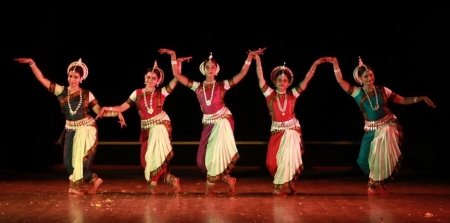 Senior dancers of Nrityantar
Besides being a dancer, Madhulita has to her credit a diploma in Cost Accounting. She works at various schools in the city offering special dance classes for children as well as elders. Nrityantar has been working with many schools in the city with the idea of including classical dance as an integral part of the curriculum and routine schooling. Madhulita’s aim is that the children should enjoy something amidst the monotonous school activities, and along with it, they get to learn dance forms and a bit of our rich culture also. She also feels that different styles of Odissi should be showcased. On 16th August Madhulita presented her disciples ranging from tiny tots to elders in group, duet and solo numbers giving an idea of the training they have been receiving from her. Essentially it was like a parents’ day, where parents can watch the progress of their offspring. What impressed one most was the hard work that goes behind this presentation and offers the viewer an idea about the standard Madhulita aims the students to achieve. No wonder the level therefore is bound to vary for certain groups, duets and solos. It would be invidious to single out few dancers for their presentation in terms of critical appreciation. The event as all such parents’ day events are was more in term of numbers who strive to work hard to master the technique of Odissi and perform on stage, to gain confidence and also joy of dancing. I was struck by Shrinika, barely 3 and ½ years old, performing Namami Vighnaraja tam prayer using the hastas and pada bhedas with natural ease. So, naturally I was carried away by her innocent smile, expressions, hastas and placing of the feet, trying to evoke expressions as best as any tiny tot would try to do. And indeed she stole the hearts of the audience. It is too early to forecast that she is a child prodigy and would indeed be a dancer to watch. But going by her interest in watching dance, and performing without any inhibition or stage fright one felt she would blossom into a fine dancer, if all goes well and she continues to learn and perform. 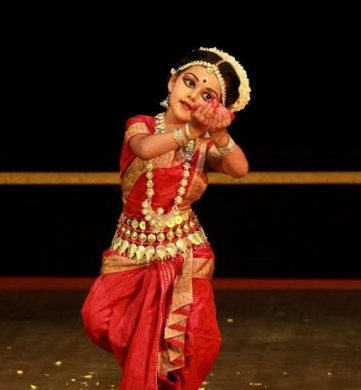 Shrinika Purohit
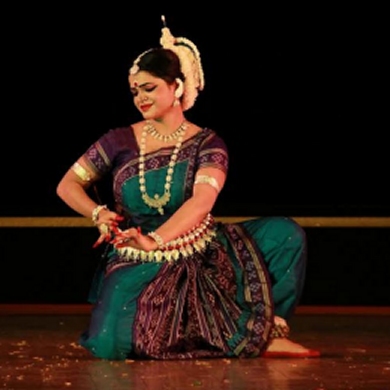 Gargi Nayak Two young dancers performed well known Gopal Krishna’s Odiya song To laagi Gopa danda mana re Kaliya suna impersonating Krishna and a young gopi. It suited their age and looked naive and charming. This is my favourite Odiya song and I have seen it being performed by several dancers including Guru Kelucharan Mohapatra and also the Gotipua boys dressed as girls. It has a distinct appeal. In this version, the young gopi took Krishna and locked him up in a room and went away. And that ending also looked quite charming. Gargi Nayak, a senior disciple of Meera Das from Cuttack, enacted another favourite song of mine, Baji chhi bajarae song of Banamali where a sakhi tells Radha, “Your scandalous love affair with Krishna is so well known, so restrain yourself. People know why you stand in the balcony and dry your hair in full view of one and all, and who comes to watch it! You are shameless. Going to Jamuna to fetch water, seeing Krishna’s reflection in water, he climbing the tree and your rendezvous is known to all.” The various instances of their clandestine meetings are spoken to Radha to no effect and she drags her away from public gaze. Gargi expressed all these nuances competently. Earlier, I had seen Madhulita performing it as a duet and noticed that the song offers scope to a mature dancer to invest it with variegated emotions. 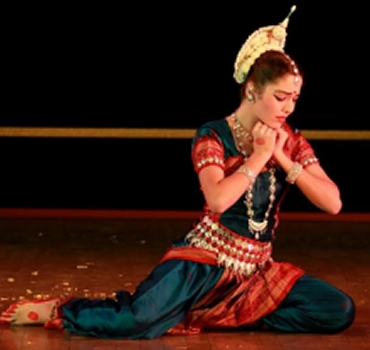 Freya Stamets
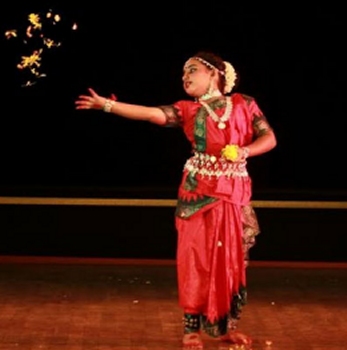 Arushi Chaudhuri I happened to spend a day at Madhulita’s residence cum school and also saw her solos, which she specially performed for me. The ashtpadi Yahi Keshava - Go away Krishna - depicting khandita nayika from the Gita Govinda as taught to her by Guru Deba Prasad Das, offered me an opportunity to explain to her that she needs to choreograph with additional inputs of sancharis for rasanubhava and also intensity of agony of Radha at Krishna’s truant behaviour. I recalled the interesting observations late Jiwan Pani and I had. The text mentions Radha telling Krishna not to tell lies - Ma vada kaitava vadam. In Guru Kelucharan Mohapatra’s choreography, Guruji shows Krishna trying to pacify Radha that what she points out as tell tale marks of he having kissed the eyes of other gopis and the black of the eyes clearly seen on his lips, is not the black of the kohl, but marks of juice of blackberries he had tested before bringing them for her. Then when Radha points out to him the nail marks on his body, he tries to convince her that to pluck flowers he got bruised with the thorns and so on. Radha then tells Krishna, “Why do you lie to us, innocent ones?” - Kathamat vanchayase janamanugata? These lines have connection with the import of the ashtapadi, when Radha says, ‘Ma vada kaitava vadam.’ I remember Jiwan Pani did not like Krishna inventing such lies, and I used to argue and ask then how does Krishna behave? And invent lies? In Manabhanjan poem, these incidents are mentioned, and in the Odissi tradition, kavya has a definite place. Krishna is 'shatha' nayaka, clever and deceiver. Madhulita has maintained the dignity of uttama nayika to reinforce the kaitava, lies. After studying the commentary of Kumbharana and Rasik Priya given below the printed text of the Gita Govindam, Jiwan Pani told us why Radha addresses Krishna as Madhava. Dhava is Lakshmi and Madhav is her husband. Since Lakshmi is chanchal, fickle, no wonder Krishna, you are also fickle. Therefore analysing the words used by the poet, the dancer has to invest the ashtapadi with nuances. Madhulita also competently performed for me Ramati Yamuna teere as taught to her by Aruna Mohanty. It reflected Aruna’s handling of the ashtapadi taking into account the situation and state of Radha’s mind seeing Krishna playing with other gopis on banks of the river and asking her to leave her pride and be one with her beloved and go and meet him. Our discussion helped both of us to interact. This aside is important because when critics are invited to such festivals, they often do not find space for a dialogue. The second day featured Leena Mohanty, a disciple of Deba Prasad Das and currently learning under Durgacharan Ranbir. She has been artistic director of Trinayan school of Odissi in New York and has worked in Kuala Lumpur with Ramli Ibrahim. Ever wanting to expand her dance horizons, she presented three choreographic numbers of her own. Leena has now settled down in Bangalore and there is thus one more addition of a seasoned Odissi dancer to the city. With her pleasant personality and evoking a feeling of joy in whatever she was dancing, Leena succeeded in conveying her command over the idiom to the audience. After Mangalacharan in Jana Sammohini raga and tala khemta and ekatali, she danced a pallavi in Madhyamavati raga and ekatali. It was full of expression of a nayika enjoying the rain showers. The raga was closer to Malhar and the dance movements she employed were suggestive of the raindrops falling on her and the resultant joy. The lightning and looking at the overcast sky et al were employed by her using pure dance to suggest rain. The circular movements covering the stage and turning in front and back looking over the shoulders looked interesting in terms of using space. But what was most interesting was her presentation of Bhramaragita from Shrimad Bhagavata, 10th canto and chapter 47. She selected only three episodes to tell Vidura who was sent by Krishna to Vraja to find out how Radha was recalling Krishna’s love in contrast to what Vidura was talking of the supremacy of knowledge (gyan) over love (prema). Radha is seen talking to a bumble bee (bhramara) whom she takes as a messenger of Krishna. Radha tells the bee: ‘O honey bee, O friend of a deceiver, do not touch my feet with your whiskers. They are smeared with kumkum that rubbed on to Krishna’s garland. These garlands were crushed by the breasts of the rival women of Mathura with whom Krishna has been dallying. Let Krishna placate the women of Mathura. A messenger like you being sent by Krishna will don’t you know be ridiculed in Yadu’s assembly? Did he not abondon us after allowing us to drink nectar of his lips - just like you O Bhramara, who might quickly abandon some flowers? We are sure that Goddess Lakshmi who is pressing his feet must have also been deceived by him with his deceitful sweet words. We know how treacherous he can be. For instance, in his incarnation as Lord Rama, did he not deceive during the fight between Vali and Sugriva? I am ashamed of what he did to Vali and also to Shurpanaka. As Vamana did he not pushed Bali raja to patal (nether land)?” After all this, she cannot resist asking the bee: “Tell me, has my beloved sent you here again? Does he remember his father’s household affairs and his friends, the cowherd boys? Does he ever talk about us, his maid servants? Tell us when will he lay his scented hands on our heads?” Leena choreographed all these sequences graphically to the music by Gopal Chandra Panda. Rarely one comes across Bhramaragita being performed. I remember under the guidance of late Dr. Premlata Sharma in Varanasi, Bhramaragita was performed. 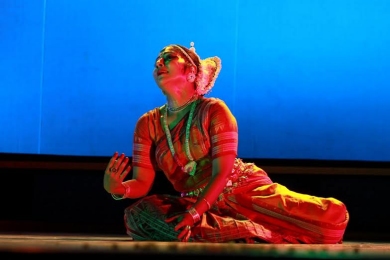 Leena Mohanty 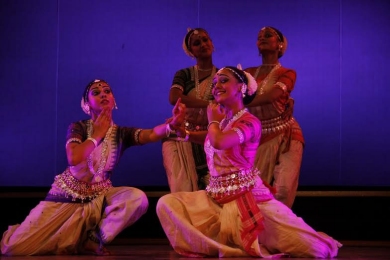 Nrityagram Dance Ensemble In their aharya, costumes, appearance, grouping, entries and exits they revealed unmistakable touch of Nrityagram training and presentation. Their movements had perfect synchronisation, grace and overall sophistication. One felt reassured of the bright future they are bound to carve for themselves. It was suggestive of all inclusive approach of Madhulita to bring variety of Odissi as seen in Bangalore. The five dancers displayed their talent, how it was nurtured at Nrityagram. Next day at Bharatiya Vidya Bhavan, they once again performed the same number and one could see how well trained they are. 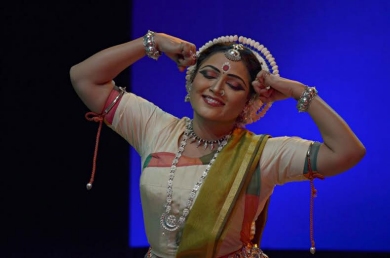 Kavita Dwibedi
Next was a composite performance of a solo choreographic work by Guru Harekrishna Behera’s daughter Kavita Dwibedi. It is a collaboration between a dancer and an Odiya poet Kedar Mishra who has been scripting libretto taking specific themes. ‘Shweta Mukti’ deals with five women in the life of Lord Buddha and how they achieved moksha, release from life circle - Gautami, the foster mother, Yashodhara, the wife, Amrapali, the courtesan, Magandhi, the arrogant and rejected queen, Prakriti, the daughter of Chandalika, a downtrodden woman. The poet has dealt with each woman different from each other, but all of them had one common goal to achieve mukti, nirvana. Each one journeys through self discovery. According to Kedar Mishra, he has attempted the poetic narrative abstraction while weaving in a story of human aspiration. Though they are historical figures, he suggests that they are modern with relevance to contemporary world and time. Kavita succeeds in depicting each one of them distinctly and carves their character in keeping with the poetic import. With enough experience, Kavita has mastered the technique. She has received good support from musicians Rama Hari Das, K. Rama Rao Patra, with rhythm composition by Dhaneswar Swain, and team work of percussionists and instrumentalists with poetic recitation by Aavery Chaudhury, Arshiya Sethi, Sukhanshu Chatterjee and some passages are rendered by Kavita herself. English translations of poems are by Amarendra Khatua. This is a very good work dealing with life of Buddha and women in his life. However, for presentation along with other artists during one evening, this presentation is too long exceeding 50 minutes. Kavita would do well to condense it for a program where other artists are to participate. Naman festival was a runaway success with meticulous planning and support from Madhulita’s husband Imran and their friend Asif. Broadening the scope of Odisssi in Bangalore, Madhulita has rendered a commendable service to include other Odissi exponents from other cities and from within Bangalore.  Dr. Sunil Kothari is a dance historian, scholar, author and a renowned dance critic. He is Vice President of World Dance Alliance Asia Pacific India chapter, based in New Delhi. He is honored by the President of India with Padma Shri, Sangeet Natak Akademi award and Senior Critic Award from Dance Critics Association, NYC. He is a regular contributor to www.narthaki.com, the roving critic for monthly magazine Sruti and is a contributing editor of Nartanam for the past 12 years. Post your comments Pl provide your name and email id along with your comment. All appropriate comments posted with name and email id in the blog will also be featured in the site. |